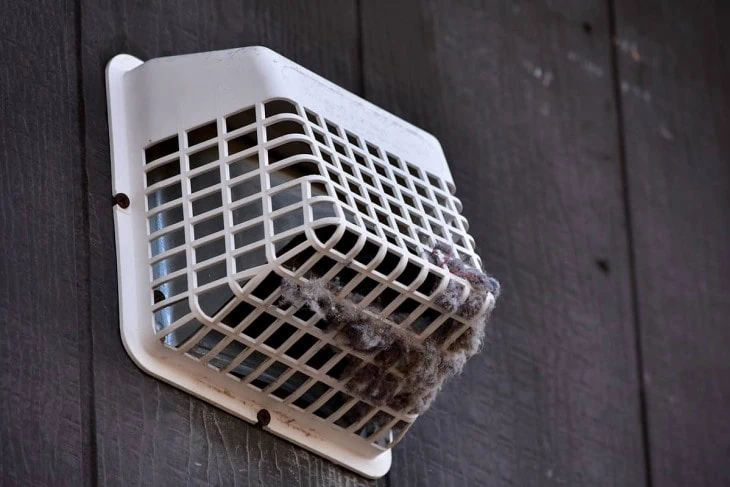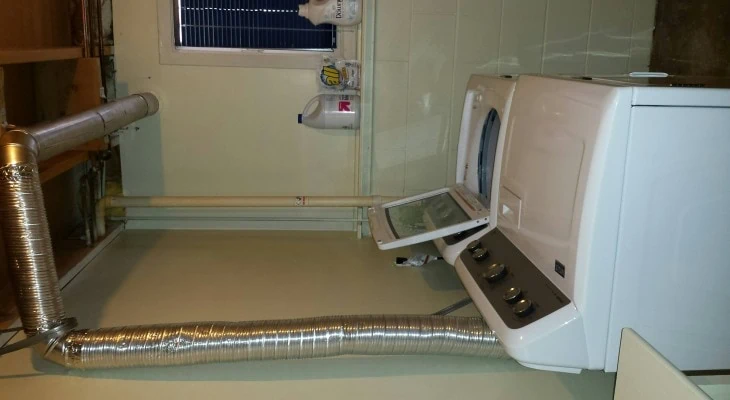The convenience of a dryer is sometimes offset by the need to vent it to the outside. This can be avoided with some models but is generally required for most.
Not venting your dryer properly can cause many problems, including health hazards and damage to your property.
The easiest option to vent a dryer without a vent to the outside is to run a hose through a window. Commercial vent kits can facilitate a more permanent setup. Alternatively, you can run a vent hose yourself as a temporary solution. Finally, lint trap filters can allow you to vent your dryer indoors, provided you’re not using a gas model.
Table of Contents
Vent Through a Window

If your dryer is close enough to a window, you should be able to run a vent through it. If you’re renting the place, make sure to check with your landlord if that’s allowed.
Even if you’re only installing a temporary vent with a simple hose, you might be violating your rental contract.
Your approach will also depend on whether you’re planning to eventually relocate the dryer or if this is a permanent arrangement. The market offers solutions for both cases.
Using a Vent Kit
Commercial vent kits are a great option if you want to vent your dryer through your window permanently, or at least for a longer-term. They typically include a section that attaches to your window, creating a seam that doesn’t degrade the appearance of the home.
This section is connected to a hose, which then hooks up directly to your drier. Connecting everything is often easy and can be done with common household tools. All necessary accessories should be included in the main package.
The two main considerations when purchasing a dryer vent kit are the length of the area between the dryer and the window, and the shape of your window. If your window is too thin, you might not be able to use certain kits with wider window attachment sections.
Using a Vent Hose
If you’re only looking for a temporary solution, a simple vent hose should do the job just fine without having to use a whole kit. It will look a bit messy if you just leave it hanging out the window, however.
But as long as you’re not venting your dryer out of a front window and you have a plan to replace this setup in the future, that shouldn’t be a problem.
Make sure to secure the window carefully to prevent it from accidentally closing on the vent hose. If this happens without you noticing, it can create a dangerous situation in your home. It’s a good idea to arrange things in a way that the window is always visible from where the dryer is.
Lint Trap Filter

If venting out a window is not an option, you can also purchase a lint trap filter. This is a small device that attaches to the end of your dryer vent hose and filters the air that passes through it. It collects all the lint, and often most of the moisture that comes out as well.
Lint trap filters are great when using one is an option, but you must be careful. Gas dryers produce toxic gases on top of the heat and moisture they expel. Those must always be vented to the outside, and a lint trap filter is not a viable substitute for proper venting.
You must also be careful with moisture. If you live in an area with higher humidity, venting indoors can lead to excessive moisture build-up and promote the growth of mold. Excessive humidity can also make the air potentially harmful to you, especially if you have certain health conditions.
Move the Dryer to a Different Part of Your Home
In some cases, none of the above options will be available. The only thing to do if you insist on using your dryer in that situation is to move it to a different part of your home.
The basement is a good idea. It will often have windows you can hook your dryer up to and should be better at withstanding the effects of moisture than the rest of your home. It will also help keep the dryer away from the main living areas of the home.
Plus, it’s a part of your home that you likely spend very little time in, making it less likely that you’ll get affected by any negative side effects of venting your dryer indoors.
You must still proceed with caution if that’s what you’re planning to do though – remember, gas dryers must always be vented to the outside!
Do All Dryers Need a Vent?
Some dryer models are designed to run without a vent. However, this comes with some compromises. Those dryers are usually smaller and with a reduced capacity. They may also need a longer time to complete a full load.
On the other hand, many ventless dryers are more energy-efficient and compact than their standard vented counterparts.
People living in smaller households tend to prefer these models, as do users with a limited capacity to make changes to their homes. Renters are perhaps the most common example in this category.
Do I Need to Vent to the Outside?

As we mentioned above, venting a dryer indoors is occasionally an option, provided you’ve done your research on related health hazards. If your dryer is not a gas-powered model, it’s probably safe to vent it indoors, as long as you use a lint trap filter.
Even then, you must be careful with factors like moisture. In some areas, running a dryer in this manner is not recommended because it will increase the humidity of the surrounding air to hazardous levels.
What about running a dryer without a vent? Now you’re entering dangerous territories. This is not recommended for a number of reasons, no matter what type of dryer you have.
Using a vent is necessary not just for health reasons, but also for the safety of the dryer itself. If you don’t use a vent, all that excess heat and moisture will be released right next to the dryer. It will accumulate on and around the unit and will shorten its lifespan drastically.
This is also what happens if your dryer vent is not connected properly. You may even run it that way for a while without realizing that anything is wrong. By the time you’ve discovered the problem, your dryer may already be damaged beyond repair.
So, can you use a dryer without a vent hose? Not in any safe manner, with some very specific exceptions, such as a dryer that’s practically outdoors because it’s close enough to a wide door. That introduces other problems, however, as most household dryers are not designed to be exposed to the weather.
Conclusion
Running a dryer without a vent to the outside is possible with some minor adjustments. You might have to do some modifications to your home, which can be problematic for renters.
If running a hose to a window is not an option, you should consider moving the dryer itself. Always pay attention to what type of dryer you’re using, and don’t attempt to vent a gas-powered model indoors.

